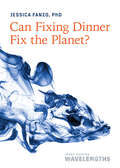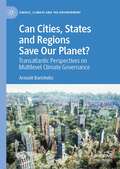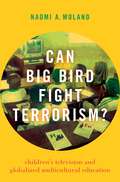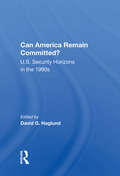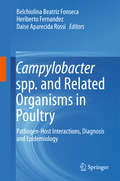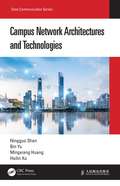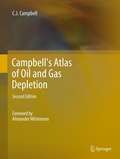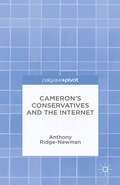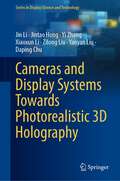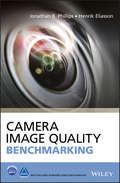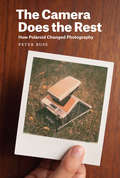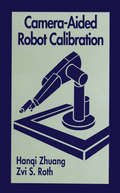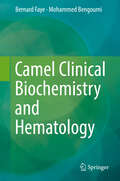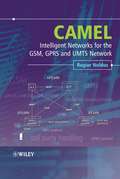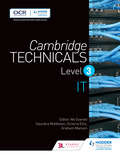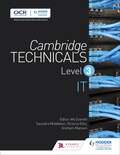- Table View
- List View
Can Fixing Dinner Fix the Planet? (Johns Hopkins Wavelengths)
by Jessica FanzoHow can consumers, nations, and international organizations work together to improve food systems before our planet loses its ability to sustain itself and its people?Do we have the right to eat wrongly?As the world's agricultural, environmental, and nutritional needs intersect—and often collide—how can consumers, nations, and international organizations work together to reverse the damage by changing how we make, distribute, and purchase food? Can such changes in practice and policy reverse the trajectories of the biggest global crises impacting our world: the burden of chronic diseases, the consequences of climate change, and the systemic economic and social inequities that exist within and among nations?Can Fixing Dinner Fix the Planet? is a clarion call for both individual consumers and those who shape our planet's food and environmental policies that:• describes the often destructive path that foods take from farms and seas through their processing, distribution, marketing, purchasing and waste management sites• explores the complex web of factors impacting our ability to simultaneously meet nutritional needs, sustain biodiversity and protect the environment• raises readers' food and environmental literacy through an engaging narrative about Fanzo's research on five continents along with the work of other inspiring global experts who are providing solutions to these crises• empowers readers to contribute to immediate and long-term changes by informing their decisions in restaurants, grocery stores, farmers markets, and kitchens
Can Fixing Dinner Fix the Planet? (Johns Hopkins Wavelengths)
by Jessica FanzoHow can consumers, nations, and international organizations work together to improve food systems before our planet loses its ability to sustain itself and its people?Do we have the right to eat wrongly?As the world's agricultural, environmental, and nutritional needs intersect—and often collide—how can consumers, nations, and international organizations work together to reverse the damage by changing how we make, distribute, and purchase food? Can such changes in practice and policy reverse the trajectories of the biggest global crises impacting our world: the burden of chronic diseases, the consequences of climate change, and the systemic economic and social inequities that exist within and among nations?Can Fixing Dinner Fix the Planet? is a clarion call for both individual consumers and those who shape our planet's food and environmental policies that:• describes the often destructive path that foods take from farms and seas through their processing, distribution, marketing, purchasing and waste management sites• explores the complex web of factors impacting our ability to simultaneously meet nutritional needs, sustain biodiversity and protect the environment• raises readers' food and environmental literacy through an engaging narrative about Fanzo's research on five continents along with the work of other inspiring global experts who are providing solutions to these crises• empowers readers to contribute to immediate and long-term changes by informing their decisions in restaurants, grocery stores, farmers markets, and kitchens
Can Cities, States and Regions Save Our Planet?: Transatlantic Perspectives on Multilevel Climate Governance (Energy, Climate and the Environment)
by Arnault BarichellaThis book examines the potential for cities, states and regions to take decisive action on climate change at the local level. Local action constitutes an essential component of global efforts to keep temperatures below the 2°C Paris Agreement threshold. Focusing on three green municipal leaders - New York, Boston and Paris - this volume examines their multilevel interactions with higher governance echelons in the United States and France. Even though these countries are located on different continents, similar patterns emerge on both sides of the Atlantic. This book explores the key role of municipalities and sub-state entities in shaping the climate policy agenda vis-à-vis national governments in the US and France. It argues that inadequate articulation of multilevel governance may jeopardize efforts to limit global temperature increase below the 2°C threshold by the end of the century.
Can Big Bird Fight Terrorism?: Children's Television and Globalized Multicultural Education
by Naomi A. MolandSesame Street has taught generations of Americans their letters and numbers, and also how to better understand and get along with people of different races, faiths, ethnicities, and temperaments. But the show has a global reach as well, with more than thirty co-productions of Sesame Street that are viewed in over 150 countries. In recent years, the United States Agency for International Development (USAID) has provided funding to the New York-based Sesame Workshop to create international versions of Sesame Street. Many of these programs teach children to respect diversity and tolerate others, which some hope will ultimately help to build peace in conflict-affected societies. In fact, the U.S. government has funded local versions of the show in several countries enmeshed in conflict, including Afghanistan, Kosovo, Pakistan, Jordan, and Nigeria. Can Big Bird Fight Terrorism? takes an in-depth look at the Nigerian version, Sesame Square, which began airing in 2011. In addition to teaching preschool-level academic skills, Sesame Square seeks to promote peaceful coexistence-a daunting task in Nigeria, where escalating ethno-religious tensions and terrorism threaten to fracture the nation. After a year of interviewing Sesame creators, observing their production processes, conducting episode analysis, and talking to local educators who use the program in classrooms, Naomi Moland found that this child-focused use of soft power raised complex questions about how multicultural ideals translate into different settings. In Nigeria, where segregation, state fragility, and escalating conflict raise the stakes of peacebuilding efforts, multicultural education may be ineffective at best, and possibly even divisive. This book offers rare insights into the complexities, challenges, and dilemmas inherent in soft power attempts to teach the ideals of diversity and tolerance in countries suffering from internal conflicts.
Can Big Bird Fight Terrorism?: Children's Television and Globalized Multicultural Education
by Naomi A. MolandSesame Street has taught generations of Americans their letters and numbers, and also how to better understand and get along with people of different races, faiths, ethnicities, and temperaments. But the show has a global reach as well, with more than thirty co-productions of Sesame Street that are viewed in over 150 countries. In recent years, the United States Agency for International Development (USAID) has provided funding to the New York-based Sesame Workshop to create international versions of Sesame Street. Many of these programs teach children to respect diversity and tolerate others, which some hope will ultimately help to build peace in conflict-affected societies. In fact, the U.S. government has funded local versions of the show in several countries enmeshed in conflict, including Afghanistan, Kosovo, Pakistan, Jordan, and Nigeria. Can Big Bird Fight Terrorism? takes an in-depth look at the Nigerian version, Sesame Square, which began airing in 2011. In addition to teaching preschool-level academic skills, Sesame Square seeks to promote peaceful coexistence-a daunting task in Nigeria, where escalating ethno-religious tensions and terrorism threaten to fracture the nation. After a year of interviewing Sesame creators, observing their production processes, conducting episode analysis, and talking to local educators who use the program in classrooms, Naomi Moland found that this child-focused use of soft power raised complex questions about how multicultural ideals translate into different settings. In Nigeria, where segregation, state fragility, and escalating conflict raise the stakes of peacebuilding efforts, multicultural education may be ineffective at best, and possibly even divisive. This book offers rare insights into the complexities, challenges, and dilemmas inherent in soft power attempts to teach the ideals of diversity and tolerance in countries suffering from internal conflicts.
Can America Remain Committed?: U.s. Security Horizons In The 1990s
by David G. HaglundThe twelve months that spanned the period between the early springtimes of 1991 and 1992 may well turn out to constitute the most important year for American foreign and security policy in half a century. Encasing the dawning of a new and different security era, like macabre parentheses, were two columns of black smoke-that of 1991 over the newly liberated Kuwait, and that of 1992 over the embattled district of South-Central Los Angeles. Within these acrid temporal brackets unfolded a set of developments of utmost significance for American foreign and security policy and for the very meaning of the country's external commitments.
Can America Remain Committed?: U.s. Security Horizons In The 1990s
by David G. HaglundThe twelve months that spanned the period between the early springtimes of 1991 and 1992 may well turn out to constitute the most important year for American foreign and security policy in half a century. Encasing the dawning of a new and different security era, like macabre parentheses, were two columns of black smoke-that of 1991 over the newly liberated Kuwait, and that of 1992 over the embattled district of South-Central Los Angeles. Within these acrid temporal brackets unfolded a set of developments of utmost significance for American foreign and security policy and for the very meaning of the country's external commitments.
Campylobacter spp. and Related Organisms in Poultry: Pathogen-Host Interactions, Diagnosis and Epidemiology
by Belchiolina Beatriz Fonseca Heriberto Fernandez Daise Aparecida RossiThis book provides an extensive review of research into Campylobacter, Helicobacter and Arcobacter species found in poultry. It includes the epidemiology, diagnosis, immune response and disease control of these organisms in commercial poultry production. Antimicrobial resistance, and the incidence and human disease potential of these bacteria is also discussed. A global perspective is presented by experts from four continents – South America, North America, Europe and Africa. This reference work will be of value to the poultry industry, research laboratories, public health workers and students. An extensive overview of the relevant literature is provided by the reference lists at the end of each chapter.
Campus Network Architectures and Technologies (Data Communication Series)
by Ningguo Shen Bin Yu Mingxiang Huang Hailin XuCampus Network Architectures and Technologies begins by describing the service challenges facing campus networks, and then details the intent-driven campus network architectures and technologies of Huawei Cloud Campus Solution. After reading this book, you will have a comprehensive understanding of next-generation campus network solutions, technical implementations, planning, design, and other know-how. Leveraging Huawei’s years of technical expertise and practices in the campus network field, this book systematically describes the use of technical solutions such as virtualization, big data, AI, and SDN in campus networks. You will be able to reconstruct campus networks quickly and efficiently utilizing this informative description. Additionally, this book provides detailed suggestions for campus network design and deployment based on Huawei's extensive project implementation experience, assisting with the construction of automated and intelligent campus networks required to cope with challenges. This is a practical, informative, and easy-to-understand guide for learning about and designing campus networks. It is intended for network planning engineers, network technical support engineers, network administrators, and enthusiasts of campus network technologies. Authors Ningguo Shen is Chief Architect for Huawei’s campus network solutions. He has approximately 20 years' experience in campus network product and solution design, as well as a wealth of expertise in network planning and design. Mr. Shen previously served as a system engineer for the campus switch, data center switch, and WLAN product lines, and led the design of Huawei’s intent-driven campus network solution. Bin Yu is an Architect for Huawei's campus network solutions. He has 12 years’ experience in campus network product and solution design, as well as extensive expertise in network planning and design and network engineering project implementation. Mr. Yu once led the design of multiple features across various campus network solutions. Mingxiang Huang is a Documentation Engineer for Huawei’s campus network solutions. He has three years of technical service experience, and four years of expertise in developing campus network product documentation. Mr. Huang was previously in charge of writing manuals for Huawei router and switch products. He has authored many popular technical series, including Be an OSPF Expert, Insight into Routing Policies, and Story behind Default Routes. Hailin Xu is a Documentation Engineer for Huawei’s campus network solutions. He has two years of marketing experience in smart campus solutions, and six years of expertise in developing network products and solution documentation. Extremely familiar with Huawei's campus network products and solutions, Mr. Xu was previously in charge of writing manuals for Huawei routers, switches, and campus network solutions. In addition, he has participated in smart campus marketing projects within such sectors as education, government, and real estate.
Campus Network Architectures and Technologies (Data Communication Series)
by Ningguo Shen Bin Yu Mingxiang Huang Hailin XuCampus Network Architectures and Technologies begins by describing the service challenges facing campus networks, and then details the intent-driven campus network architectures and technologies of Huawei Cloud Campus Solution. After reading this book, you will have a comprehensive understanding of next-generation campus network solutions, technical implementations, planning, design, and other know-how. Leveraging Huawei’s years of technical expertise and practices in the campus network field, this book systematically describes the use of technical solutions such as virtualization, big data, AI, and SDN in campus networks. You will be able to reconstruct campus networks quickly and efficiently utilizing this informative description. Additionally, this book provides detailed suggestions for campus network design and deployment based on Huawei's extensive project implementation experience, assisting with the construction of automated and intelligent campus networks required to cope with challenges. This is a practical, informative, and easy-to-understand guide for learning about and designing campus networks. It is intended for network planning engineers, network technical support engineers, network administrators, and enthusiasts of campus network technologies. Authors Ningguo Shen is Chief Architect for Huawei’s campus network solutions. He has approximately 20 years' experience in campus network product and solution design, as well as a wealth of expertise in network planning and design. Mr. Shen previously served as a system engineer for the campus switch, data center switch, and WLAN product lines, and led the design of Huawei’s intent-driven campus network solution. Bin Yu is an Architect for Huawei's campus network solutions. He has 12 years’ experience in campus network product and solution design, as well as extensive expertise in network planning and design and network engineering project implementation. Mr. Yu once led the design of multiple features across various campus network solutions. Mingxiang Huang is a Documentation Engineer for Huawei’s campus network solutions. He has three years of technical service experience, and four years of expertise in developing campus network product documentation. Mr. Huang was previously in charge of writing manuals for Huawei router and switch products. He has authored many popular technical series, including Be an OSPF Expert, Insight into Routing Policies, and Story behind Default Routes. Hailin Xu is a Documentation Engineer for Huawei’s campus network solutions. He has two years of marketing experience in smart campus solutions, and six years of expertise in developing network products and solution documentation. Extremely familiar with Huawei's campus network products and solutions, Mr. Xu was previously in charge of writing manuals for Huawei routers, switches, and campus network solutions. In addition, he has participated in smart campus marketing projects within such sectors as education, government, and real estate.
Campbell's Atlas of Oil and Gas Depletion
by Colin J CampbellCampbell's Atlas of Oil and Gas Depletion, Second Edition, is the product of a half-century of critical analysis and updating of data on the status of oil and gas depletion by country, region and the world as a whole. Separate analyses of conventional and non-conventional oil and gas, which are depleting at different rates and costs, show when these critical energy sources peak and decline. The Atlas also summarizes the history and political circumstances of each country to assess the impact on oil and gas production and reserves. It contrasts the First Half of the Oil Age, which saw the rapid expansion of the world economy, allowing the population to grow six-fold, with the Second Half, which will witness a general contraction as these easy, high-density energy supplies dwindle. The transition threatens to be a time of great economic, financial and political tensions. The Atlas, which has been compiled and updated by prominent geologist, former oil company executive, and oil analyst Colin Campbell since the 1960s, addresses the need for a reliable and comprehensive database on a subject essential to governments, industry, academia, and the population as a whole as we attempt to adapt to these critically changing circumstances.
Cameron’s Conservatives and the Internet: Change, Culture and Cyber Toryism
by A. Ridge-NewmanThe internet is changing the way we interact and communicate. But how is it impacting on more historically traditional institutions like the British Conservative Party? This book examines the role of specific internet technologies like ConservativeHome, Facebook, Twitter and WebCameron in the organizational culture of the Tory Party 2005-14.
Cameras and Display Systems Towards Photorealistic 3D Holography (Series in Display Science and Technology)
by Jin Li Jintao Hong Yi Zhang Xiaoxun Li Zilong Liu Yanyan Liu Daping ChuThis book presents recent advances in three-dimensional (3D) imaging and display frameworks, encompassing three categories of 3D imaging and display technologies. The first category is nonphotorealistic 3D approaches based on conventional optical cameras to implement 3D stereoscopic observation of a scene. In the context of nonphotorealistic 3D imaging and reconstruction systems, the authors introduce general principles and also demonstrate camera calibration for 3D imaging, smart cameras, and full-link imaging methods using the optical modulation transfer function to improve imaging quality in conventional cameras. The second category is based on light-ray light field technology to achieve photorealistic 3D imaging and displays. In the context of light-ray light field systems, two approaches capable of light-ray light field 3D imaging by utilizing a camera array or a lens array are demonstrated. Accordingly, light-ray light field display approaches comprising head-mounted displays and integral displays are also introduced. The third category is also photorealistic 3D imaging and display technology, which is based on holography (i.e., diffraction or wavefront light field). In the corresponding holographic displays, the authors introduce 3D holographic displays from three elements: algorithms, devices, and systems, involving fast hologram generation algorithms, wide-viewing-angle display systems, and metasurface holography, etc. Including an investigative roadmap for future progress in optical imaging and 3D display systems, this book is essential reading for scientists and engineers in academia and industry who are interested in next-generation imaging and display concepts for 3D visual sensing systems.
Camera Image Quality Benchmarking, Enhanced Edition (The Wiley-IS&T Series in Imaging Science and Technology)
by Jonathan B. Phillips Henrik EliassonThe essential guide to the entire process behind performing a complete characterization and benchmarking of cameras through image quality analysis Camera Image Quality Benchmarking contains the basic information and approaches for the use of subjectively correlated image quality metrics and outlines a framework for camera benchmarking. The authors show how to quantitatively compare image quality of cameras used for consumer photography. This book helps to fill a void in the literature by detailing the types of objective and subjective metrics that are fundamental to benchmarking still and video imaging devices. Specifically, the book provides an explanation of individual image quality attributes and how they manifest themselves to camera components and explores the key photographic still and video image quality metrics. The text also includes illustrative examples of benchmarking methods so that the practitioner can design a methodology appropriate to the photographic usage in consideration. The authors outline the various techniques used to correlate the measurement results from the objective methods with subjective results. The text also contains a detailed description on how to set up an image quality characterization lab, with examples where the methodological benchmarking approach described has been implemented successfully. This vital resource: Explains in detail the entire process behind performing a complete characterization and benchmarking of cameras through image quality analysis Provides best practice measurement protocols and methodologies, so readers can develop and define their own camera benchmarking system to industry standards Includes many photographic images and diagrammatical illustrations to clearly convey image quality concepts Champions benchmarking approaches that value the importance of perceptually correlated image quality metrics Written for image scientists, engineers, or managers involved in image quality and evaluating camera performance, Camera Image Quality Benchmarking combines knowledge from many different engineering fields, correlating objective (perception-independent) image quality with subjective (perception-dependent) image quality metrics.
Camera Image Quality Benchmarking (The Wiley-IS&T Series in Imaging Science and Technology)
by Jonathan B. Phillips Henrik EliassonThe essential guide to the entire process behind performing a complete characterization and benchmarking of cameras through image quality analysis Camera Image Quality Benchmarking contains the basic information and approaches for the use of subjectively correlated image quality metrics and outlines a framework for camera benchmarking. The authors show how to quantitatively compare image quality of cameras used for consumer photography. This book helps to fill a void in the literature by detailing the types of objective and subjective metrics that are fundamental to benchmarking still and video imaging devices. Specifically, the book provides an explanation of individual image quality attributes and how they manifest themselves to camera components and explores the key photographic still and video image quality metrics. The text also includes illustrative examples of benchmarking methods so that the practitioner can design a methodology appropriate to the photographic usage in consideration. The authors outline the various techniques used to correlate the measurement results from the objective methods with subjective results. The text also contains a detailed description on how to set up an image quality characterization lab, with examples where the methodological benchmarking approach described has been implemented successfully. This vital resource: Explains in detail the entire process behind performing a complete characterization and benchmarking of cameras through image quality analysis Provides best practice measurement protocols and methodologies, so readers can develop and define their own camera benchmarking system to industry standards Includes many photographic images and diagrammatical illustrations to clearly convey image quality concepts Champions benchmarking approaches that value the importance of perceptually correlated image quality metrics Written for image scientists, engineers, or managers involved in image quality and evaluating camera performance, Camera Image Quality Benchmarking combines knowledge from many different engineering fields, correlating objective (perception-independent) image quality with subjective (perception-dependent) image quality metrics.
The Camera Does the Rest: How Polaroid Changed Photography
by Peter BuseIn a world where nearly everyone has a cellphone camera capable of zapping countless instant photos, it can be a challenge to remember just how special and transformative Polaroid photography was in its day. And yet, there’s still something magical for those of us who recall waiting for a Polaroid picture to develop. Writing in the context of two Polaroid Corporation bankruptcies, not to mention the obsolescence of its film, Peter Buse argues that Polaroid was, and is, distinguished by its process—by the fact that, as the New York Times put it in 1947, “the camera does the rest.” Polaroid was often dismissed as a toy, but Buse takes it seriously, showing how it encouraged photographic play as well as new forms of artistic practice. Drawing on unprecedented access to the archives of the Polaroid Corporation, Buse reveals Polaroid as photography at its most intimate, where the photographer, photograph, and subject sit in close proximity in both time and space—making Polaroid not only the perfect party camera but also the tool for frankly salacious pictures taking. Along the way, Buse tells the story of the Polaroid Corporation and its ultimately doomed hard-copy wager against the rising tide of digital imaging technology. He explores the continuities and the differences between Polaroid and digital, reflecting on what Polaroid can tell us about how we snap photos today. Richly illustrated, The Camera Does the Rest will delight historians, art critics, analog fanatics, photographers, and all those who miss the thrill of waiting to see what develops.
The Camera Does the Rest: How Polaroid Changed Photography
by Peter BuseIn a world where nearly everyone has a cellphone camera capable of zapping countless instant photos, it can be a challenge to remember just how special and transformative Polaroid photography was in its day. And yet, there’s still something magical for those of us who recall waiting for a Polaroid picture to develop. Writing in the context of two Polaroid Corporation bankruptcies, not to mention the obsolescence of its film, Peter Buse argues that Polaroid was, and is, distinguished by its process—by the fact that, as the New York Times put it in 1947, “the camera does the rest.” Polaroid was often dismissed as a toy, but Buse takes it seriously, showing how it encouraged photographic play as well as new forms of artistic practice. Drawing on unprecedented access to the archives of the Polaroid Corporation, Buse reveals Polaroid as photography at its most intimate, where the photographer, photograph, and subject sit in close proximity in both time and space—making Polaroid not only the perfect party camera but also the tool for frankly salacious pictures taking. Along the way, Buse tells the story of the Polaroid Corporation and its ultimately doomed hard-copy wager against the rising tide of digital imaging technology. He explores the continuities and the differences between Polaroid and digital, reflecting on what Polaroid can tell us about how we snap photos today. Richly illustrated, The Camera Does the Rest will delight historians, art critics, analog fanatics, photographers, and all those who miss the thrill of waiting to see what develops.
The Camera Does the Rest: How Polaroid Changed Photography
by Peter BuseIn a world where nearly everyone has a cellphone camera capable of zapping countless instant photos, it can be a challenge to remember just how special and transformative Polaroid photography was in its day. And yet, there’s still something magical for those of us who recall waiting for a Polaroid picture to develop. Writing in the context of two Polaroid Corporation bankruptcies, not to mention the obsolescence of its film, Peter Buse argues that Polaroid was, and is, distinguished by its process—by the fact that, as the New York Times put it in 1947, “the camera does the rest.” Polaroid was often dismissed as a toy, but Buse takes it seriously, showing how it encouraged photographic play as well as new forms of artistic practice. Drawing on unprecedented access to the archives of the Polaroid Corporation, Buse reveals Polaroid as photography at its most intimate, where the photographer, photograph, and subject sit in close proximity in both time and space—making Polaroid not only the perfect party camera but also the tool for frankly salacious pictures taking. Along the way, Buse tells the story of the Polaroid Corporation and its ultimately doomed hard-copy wager against the rising tide of digital imaging technology. He explores the continuities and the differences between Polaroid and digital, reflecting on what Polaroid can tell us about how we snap photos today. Richly illustrated, The Camera Does the Rest will delight historians, art critics, analog fanatics, photographers, and all those who miss the thrill of waiting to see what develops.
The Camera Does the Rest: How Polaroid Changed Photography
by Peter BuseIn a world where nearly everyone has a cellphone camera capable of zapping countless instant photos, it can be a challenge to remember just how special and transformative Polaroid photography was in its day. And yet, there’s still something magical for those of us who recall waiting for a Polaroid picture to develop. Writing in the context of two Polaroid Corporation bankruptcies, not to mention the obsolescence of its film, Peter Buse argues that Polaroid was, and is, distinguished by its process—by the fact that, as the New York Times put it in 1947, “the camera does the rest.” Polaroid was often dismissed as a toy, but Buse takes it seriously, showing how it encouraged photographic play as well as new forms of artistic practice. Drawing on unprecedented access to the archives of the Polaroid Corporation, Buse reveals Polaroid as photography at its most intimate, where the photographer, photograph, and subject sit in close proximity in both time and space—making Polaroid not only the perfect party camera but also the tool for frankly salacious pictures taking. Along the way, Buse tells the story of the Polaroid Corporation and its ultimately doomed hard-copy wager against the rising tide of digital imaging technology. He explores the continuities and the differences between Polaroid and digital, reflecting on what Polaroid can tell us about how we snap photos today. Richly illustrated, The Camera Does the Rest will delight historians, art critics, analog fanatics, photographers, and all those who miss the thrill of waiting to see what develops.
Camera-Aided Robot Calibration
by Hangi Zhuang Zvi S. RothRobot calibration is the process of enhancing the accuracy of a robot by modifying its control software. This book provides a comprehensive treatment of the theory and implementation of robot calibration using computer vision technology. It is the only book to cover the entire process of vision-based robot calibration, including kinematic modeling, camera calibration, pose measurement, error parameter identification, and compensation.The book starts with an overview of available techniques for robot calibration, with an emphasis on vision-based techniques. It then describes various robot-camera systems. Since cameras are used as major measuring devices, camera calibration techniques are reviewed.Camera-Aided Robot Calibration studies the properties of kinematic modeling techniques that are suitable for robot calibration. It summarizes the well-known Denavit-Hartenberg (D-H) modeling convention and indicates the drawbacks of the D-H model for robot calibration. The book develops the Complete and Parametrically Continuous (CPC) model and the modified CPC model, that overcome the D-H model singularities. The error models based on these robot kinematic modeling conventions are presented.No other book available addresses the important, practical issue of hand/eye calibration. This book summarizes current research developments and demonstrates the pros and cons of various approaches in this area. The book discusses in detail the final stage of robot calibration - accuracy compensation - using the identified kinematic error parameters. It offers accuracy compensation algorithms, including the intuitive task-point redefinition and inverse-Jacobian algorithms and more advanced algorithms based on optimal control theory, which are particularly attractive for highly redundant manipulators. Camera-Aided Robot Calibration defines performance indices that are designed for off-line, optimal selection of measurement configurations. It then describes three approaches: closed-form, gradient-based, and statistical optimization. The included case study presents experimental results that were obtained by calibrating common industrial robots. Different stages of operation are detailed, illustrating the applicability of the suggested techniques for robot calibration. Appendices provide readers with preliminary materials for easier comprehension of the subject matter. Camera-Aided Robot Calibration is a must-have reference for researchers and practicing engineers-the only one with all the information!
Camera-Aided Robot Calibration
by Hangi Zhuang Zvi S. RothRobot calibration is the process of enhancing the accuracy of a robot by modifying its control software. This book provides a comprehensive treatment of the theory and implementation of robot calibration using computer vision technology. It is the only book to cover the entire process of vision-based robot calibration, including kinematic modeling, camera calibration, pose measurement, error parameter identification, and compensation.The book starts with an overview of available techniques for robot calibration, with an emphasis on vision-based techniques. It then describes various robot-camera systems. Since cameras are used as major measuring devices, camera calibration techniques are reviewed.Camera-Aided Robot Calibration studies the properties of kinematic modeling techniques that are suitable for robot calibration. It summarizes the well-known Denavit-Hartenberg (D-H) modeling convention and indicates the drawbacks of the D-H model for robot calibration. The book develops the Complete and Parametrically Continuous (CPC) model and the modified CPC model, that overcome the D-H model singularities. The error models based on these robot kinematic modeling conventions are presented.No other book available addresses the important, practical issue of hand/eye calibration. This book summarizes current research developments and demonstrates the pros and cons of various approaches in this area. The book discusses in detail the final stage of robot calibration - accuracy compensation - using the identified kinematic error parameters. It offers accuracy compensation algorithms, including the intuitive task-point redefinition and inverse-Jacobian algorithms and more advanced algorithms based on optimal control theory, which are particularly attractive for highly redundant manipulators. Camera-Aided Robot Calibration defines performance indices that are designed for off-line, optimal selection of measurement configurations. It then describes three approaches: closed-form, gradient-based, and statistical optimization. The included case study presents experimental results that were obtained by calibrating common industrial robots. Different stages of operation are detailed, illustrating the applicability of the suggested techniques for robot calibration. Appendices provide readers with preliminary materials for easier comprehension of the subject matter. Camera-Aided Robot Calibration is a must-have reference for researchers and practicing engineers-the only one with all the information!
Camel Clinical Biochemistry and Hematology
by Bernard Faye Mohammed BengoumiThis work brings together a wealth of data regarding the reference values and factors of variation in biochemical parameters used by camel veterinarians and scientists to determine these animals’ nutritional and clinical status. It also explores several technical aspects involved in determining these parameters, sampling procedures, and essential elements in the interpretation of the results. Though many texts are available on small and large ruminants, much less is known about species confined to the marginal zones of tropical and Mediterranean countries, such as camels. This book addresses precisely this research gap, on the one hand by presenting an extensive review of the literature, and on the other by synthesizing the outcomes of the authors’ numerous previous works. In veterinary medicine, blood tests to help diagnose diseases in cattle were first proposed nearly a century ago, but were mainly developed in the 1960s, initially at specialized research or veterinary services laboratories, and eventually, with the advent of new equipment and the miniaturization of the analyzers, finding their way into veterinarians’ cabinets. Beyond their diagnostic value, veterinary surgeons and zootechnicians also speculated on the potential use of blood tests to evaluate animals’ nutritional status. Thus, a whole range of analyses are now proposed to the stakeholders responsible for animal health. Such analyses could help to define a metabolic profile, which would offer a valuable decision-making tool for experts and researchers alike.
CAMEL: Intelligent Networks for the GSM, GPRS and UMTS Network
by Rogier NoldusLearn how to use CAMEL to transfer the Intelligent Network concept to the mobile world! CAMEL (Customized Application for the Mobile network Enhanced Logic) is a standard for Intelligent Networks for mobile communications networks. It is currently deployed in all regions of the world, enabling mobile network operators to offer fast and efficient services to their subscribers. This book is an in-depth and dedicated reference on CAMEL, taking the reader through the history and development of Intelligent Networks and the essential principles of CAMEL, to the future of the technology. The author provides guidance on the various standards and specifications, and explains not only how CAMEL works but also why it works this way. Practical hints on the installation of CAMEL in the network are given throughout the book. CAMEL: Intelligent Networks for the GSM, GPRS and UMTS Network: Offers a comprehensive guide to implementing CAMEL. Gives a complete picture, including the network entities & data flows involved. Describes and explains the four CAMEL phases and their aspects. Presents an overview of the principles of Intelligent Networks, such as Finite State Machines, Trigger Detection Points, Event Detection Points and dialogue, essential to understanding CAMEL. Covers charging and accounting issues, and the impact of CAMEL on the charging system in the mobile network. Provides practical hints over and above those mentioned in the formal specifications. This text will be an invaluable resource for intelligent network service logic designers, service network designers, network engineers, and GSM/UMTS network designers and implementers. Advanced students on courses such as ‘Intelligent Networks’, ‘Value Added Services’, and ‘Service Networks’ will also find it an excellent guide to the topic.
Cambridge Technicals Level 3 IT (PDF)
by Victoria Ellis Graham Manson Saundra Middleton Maureen EverettSupport your teaching of the new Cambridge Technicals 2016 suite with Cambridge Technical Level 3 IT, developed in partnership between OCR and Hodder Education; this textbook covers each specialist pathway and ensures your ability to deliver a flexible course that is both vocationally focused and academically thorough.Cambridge Technical Level 3 IT is matched exactly to the new specification and follows specialist pathways in IT Infrastructure Technician, Emerging Digital Technology Practitioner, Application Developer, and Data Analyst.- Ensures effective teaching of each specialist pathway offered within the qualification.- Focuses learning on the skills, knowledge and understanding demanded from employers and universities.- Provides ideas and exercises for the application of practical skills and knowledge.- Developed in partnership between Hodder Education and OCR, guaranteeing quality resources which match the specification perfectly
Cambridge Technicals Level 3 IT
by Victoria Ellis Graham Manson Saundra MiddletonExam Board: CambridgeLevel: Key Stage 4Subject: ITFirst Teaching: September 2016First Exam: June 2017Support your teaching of the new Cambridge Technicals 2016 suite with Cambridge Technical Level 3 IT, developed in partnership between OCR and Hodder Education; this textbook covers each specialist pathway and ensures your ability to deliver a flexible course that is both vocationally focused and academically thorough.Cambridge Technical Level 3 IT is matched exactly to the new specification and follows specialist pathways in IT Infrastructure Technician, Emerging Digital Technology Practitioner, Application Developer, and Data Analyst.- Ensures effective teaching of each specialist pathway offered within the qualification.- Focuses learning on the skills, knowledge and understanding demanded from employers and universities.- Provides ideas and exercises for the application of practical skills and knowledge.- Developed in partnership between Hodder Education and OCR, guaranteeing quality resources which match the specification perfectly
